Shifting to minimalism can bring clarity and emotional relief to your life. Many people start by decluttering small areas, easing the emotional burden of letting go. It's helpful to achieve mindfulness by reflecting on what truly matters. Connecting with a supportive community can inspire you as you navigate challenges. You'll discover practical tips and personal stories that make the process smoother, encouraging a fulfilling lifestyle aligned with your values. There's so much more to explore about this transformative journey.
Key Takeaways
- Many find emotional relief and clarity by decluttering, often realizing their attachments complicate the process.
- Starting with less sentimental items helps build confidence in letting go of possessions.
- The "30-Day Minimalism Game" offers a structured approach to gradual decluttering.
- Creating routines and cozy spaces fosters a peaceful environment that enhances mental well-being.
- Engaging with supportive communities provides motivation and accountability throughout the minimalist journey.
Personal Journeys to Minimalism
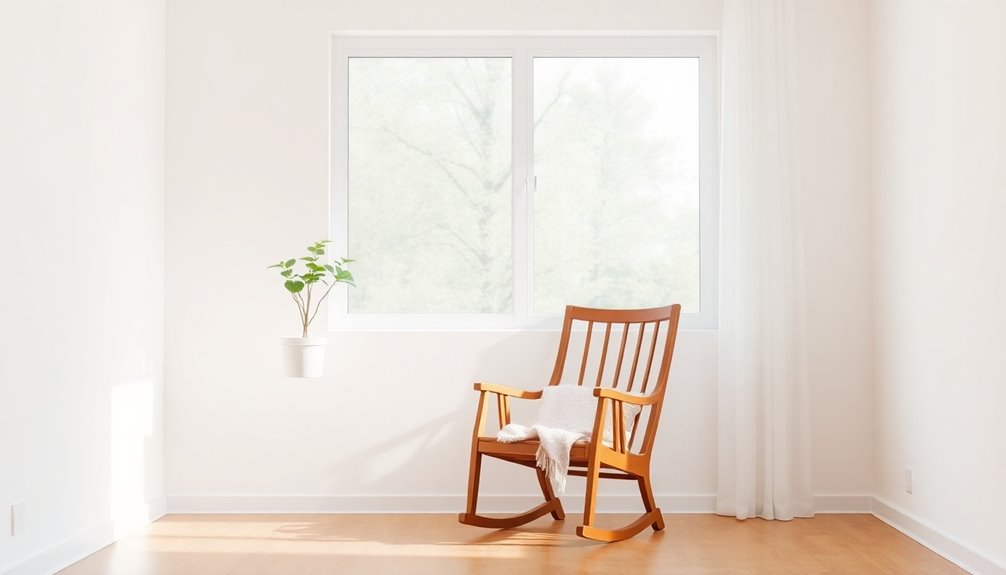
Many people find their path to minimalism begins with a moment of realization, like feeling overwhelmed by clutter or facing emotional turmoil.
This turning point often sparks personal journeys toward intentional living, prompting you to declutter your home and simplify your surroundings. As you let go of a substantial percentage of your possessions, you'll likely experience emotional relief, leading to a clearer mindset and increased focus on what truly matters—a more meaningful life.
Engaging with community support can be invaluable during this shift, as shared experiences provide motivation and encouragement. Establishing routines aids in maintaining mental clarity and can further enhance your minimalist journey.
Documenting your journey through journaling or blogging not only tracks your progress but also inspires others exploring the minimalist lifestyle.
Embrace this transformative process and discover the freedom it offers.
Emotional Attachments and Letting Go

When you start decluttering, the emotional attachments to your possessions can make the process feel overwhelming. These connections often arise from cherished memories or social expectations, causing you to fear losing part of your identity.
However, recognizing that the value of items lies in the memories they evoke can help you reassess their significance, making it easier to let go. Begin with less emotionally charged items to gradually build your confidence in simplifying your life.
Reaching out for support from friends or community groups can provide encouragement and accountability, easing the emotional burden. Additionally, understanding the importance of self-reflection can aid in processing your emotions during this transition.
Practical Tips for Decluttering

When you start decluttering, tackle one small area each day to keep from getting overwhelmed.
Prioritize your items by categorizing them, which helps you see what truly matters.
This approach makes it easier to let go of the non-essentials and create a more peaceful space. Additionally, consider using natural materials in your decor to enhance the calming effect of your minimalist environment.
Start Small Daily
To make decluttering feel less overwhelming, start by dedicating just 10-15 minutes each day to tackle a specific area in your home. This approach makes your minimalism journey manageable and less intimidating. Use the "one in, one out" rule to maintain balance; whenever you acquire something new, give away an existing item. You might also try the "30-Day Minimalism Game," where you gradually declutter more each day. Keeping a donation box accessible encourages you to continuously declutter. Here's a simple table to help you track your daily progress:
| Day | Items Decluttered | Total Items |
|---|---|---|
| 1 | 1 | 1 |
| 2 | 2 | 3 |
| 3 | 3 | 6 |
| 4 | 4 | 10 |
| 5 | 5 | 15 |
Additionally, maintaining a clean home can enhance mental well-being, making it easier to focus on your minimalism goals.
Categorize and Prioritize Items
- Identify Categories: Sort items into groups like clothing, kitchenware, and books.
- Assess Usage: Prioritize what to keep based on how often you use each item and the joy it brings.
- Apply the One-Year Rule: If you haven't used an item in the past year, consider donating or discarding it.
Utilize a "keep, donate, discard" system to streamline your decision-making. This helps you focus on minimalism, ensuring you only hold onto items that add value to your life. Additionally, consider how many of your belongings, like toys, can enhance your child's development through educational benefits while minimizing clutter in your home.
The Importance of Intentional Living
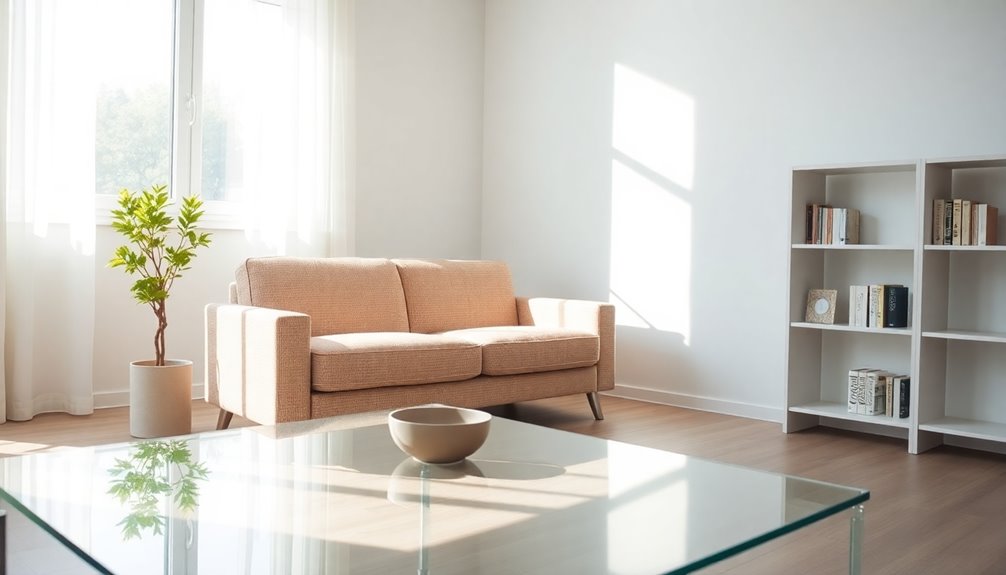
How can intentional living transform your life? By embracing minimalism, you can make room for what truly matters.
Intentional living encourages you to let go of distractions and possessions that don't align with your values. This shift allows you to focus on quality time spent with loved ones and meaningful experiences.
As you reflect on your priorities, you'll develop better decision-making skills, leading to increased clarity and focus. Simple living reduces the stress and overwhelm caused by societal pressures, enhancing your overall well-being. Moreover, creating cozy spaces can significantly contribute to a more peaceful and intentional home environment.
Building a Supportive Community
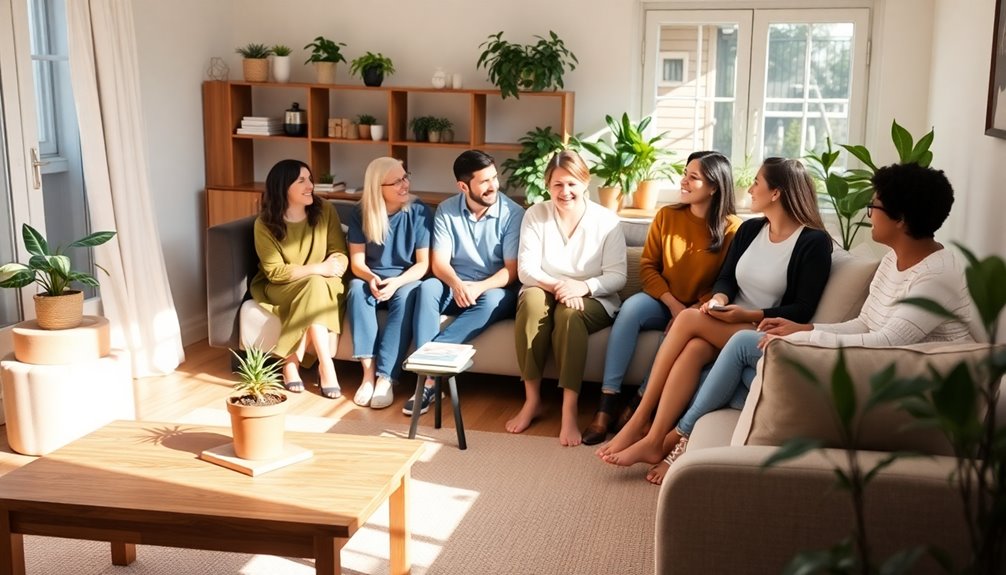
Building a supportive community can make your minimalist journey much smoother.
By sharing your personal experiences and connecting with others online, you'll find encouragement and insights that resonate with your own challenges.
Engaging with like-minded individuals not only boosts motivation but also helps you feel less isolated in your change. Additionally, fostering a network can allow you to explore counseling support for emotional challenges associated with lifestyle transitions.
Sharing Personal Experiences
When you share your personal experiences with minimalism, you not only foster a sense of community but also provide valuable support and encouragement to others on similar journeys.
By documenting your minimalist journey, you create resources to help others navigate their own paths. Here are three ways to engage:
- Discuss your challenges: Talk about getting rid of items and the emotions attached to them.
- Celebrate victories: Share successes, no matter how small, to inspire others.
- Connect with others: Join local or virtual groups to exchange insights and foster accountability. Additionally, sharing your experiences can enhance mental health benefits by promoting a more positive mindset and resilience.
Online Support Networks
Have you ever felt isolated in your journey toward minimalism? Connecting with online support networks can change that.
These platforms, like social media groups and forums, allow you to engage with a community that shares your goals. You'll find motivation through shared stories, encouragement, and resources tailored to your minimalism journey.
Participate in collaborative decluttering challenges, such as the "30-Day Minimalism Game," to stay accountable and inspired. Additionally, virtual workshops offer practical tips and strategies to simplify your life while linking you to others on similar paths.
Embracing these online communities not only enhances your commitment but also provides invaluable emotional support as you navigate the ups and downs of minimalism. Furthermore, engaging in online communities can foster support and collaboration among members, amplifying your journey toward a simpler life.
Overcoming Challenges in the Transition

- Acknowledge Emotional Attachments: Recognize that letting go of items can be tough, especially if they hold sentimental value.
- Take Gradual Steps: Focus on one area at a time to avoid feeling overwhelmed. This makes the journey toward a minimalist lifestyle more manageable.
- Seek Support: Join community groups or online resources for encouragement and accountability. Sharing your experiences with others can make a significant difference. Additionally, mindfulness practices can help ease the emotional burden of decluttering by promoting a sense of peace and acceptance.
The Lasting Benefits of Minimalism
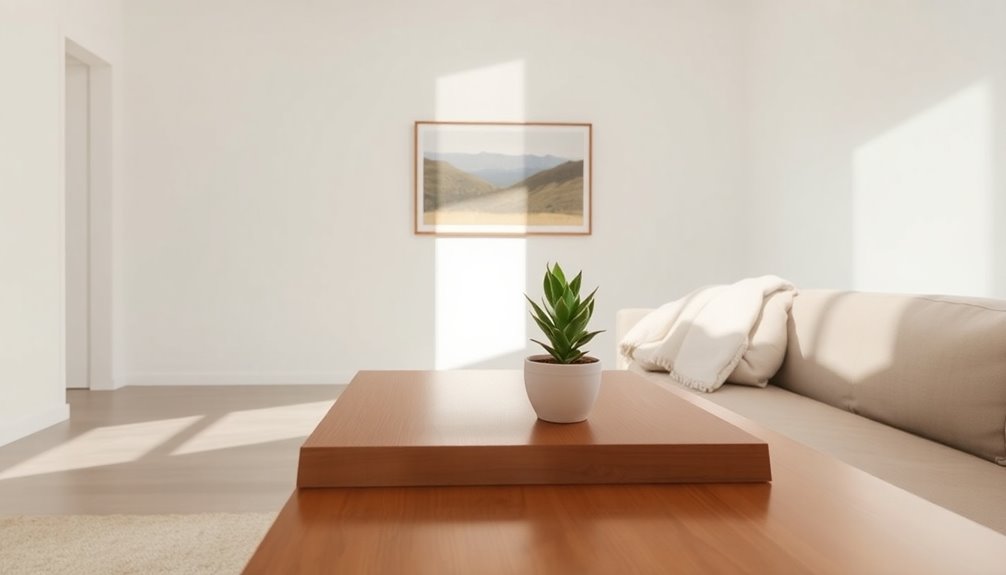
Many people discover that embracing minimalism transforms their lives in profound ways. By prioritizing essential spending, you can greatly reduce debt and financial obligations, freeing up resources for what truly matters.
This intentional approach fosters emotional well-being, as you experience less anxiety and mental clutter, leading to a clearer mind. As you declutter, you'll likely find yourself focusing more on meaningful connections with loved ones, enriching your relationships.
Minimalism empowers you to live authentically and true to your values, allowing you to pursue passions that bring joy and satisfaction.
Ultimately, this lifestyle offers a liberating sense of freedom from societal pressures, guiding you toward a life that resonates deeply with who you are.
Reflecting on Your Minimalist Journey
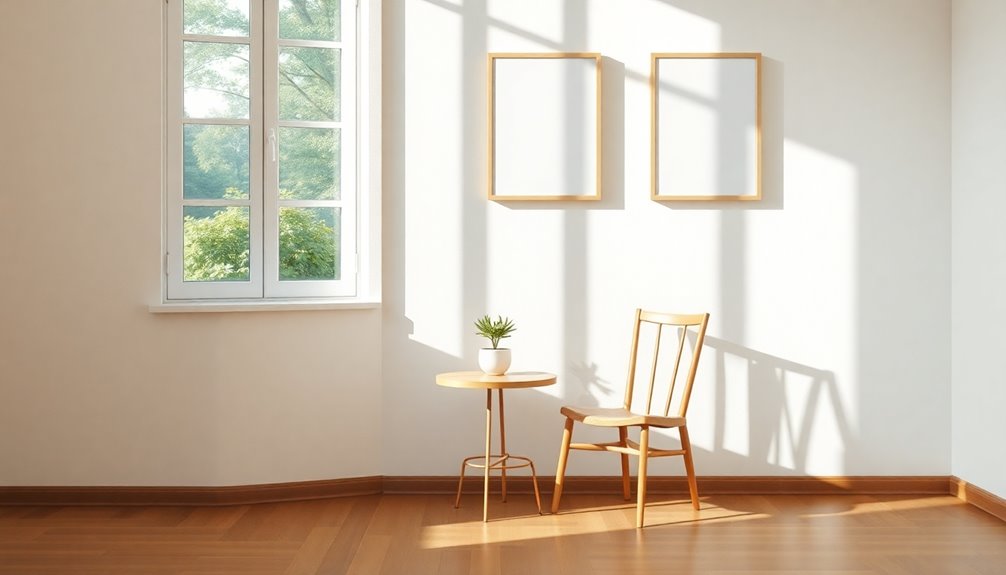
How has your minimalist journey shaped your perspectives and priorities? Reflecting on your experiences can reveal the emotional impact of decluttering, fostering self-acceptance and intentional living.
Take a moment to contemplate:
- Personal Growth: Regular reflection helps identify your true priorities and values.
- Clarity and Freedom: Reducing possessions can alleviate mental clutter, leading to stress relief.
- Community Connections: Sharing your journey with others can enhance motivation and provide essential support.
As you continue this journey, remember that engaging in reflection allows for adaptation and growth.
It'll help you maintain intentional living and avoid slipping back into consumerist habits. Embrace the lessons learned and cherish the fulfilling relationships that align with your aspirations.
Frequently Asked Questions
What Is the 15 Minute Rule for Becoming Minimalist?
The 15 Minute Rule for becoming minimalist is all about dedicating just 15 minutes each day to declutter.
You set a timer and tackle a specific area, like a drawer or shelf. This method makes the task manageable, so you won't feel overwhelmed.
By focusing on small, daily efforts, you'll steadily reduce clutter over time.
Plus, it helps you develop a habit of intentional living, allowing you to make mindful decisions about your possessions.
What Is the 90-90 Rule for Minimalism?
The 90-90 Rule for minimalism helps you decide what to keep or discard.
You simply ask yourself if you've used an item in the past 90 days or if you'll use it in the next 90 days. If the answer's no, it's time to let it go.
This rule not only reduces clutter but also promotes a more intentional lifestyle, allowing you to focus on what truly matters and enhances your mental clarity.
What Is the 20/20 Rule in Minimalism?
Did you know that nearly 80% of the items in our homes go unused?
The 20/20 Rule in minimalism suggests that if you can replace an item for under $20 and within 20 minutes, it's probably not worth keeping.
This rule helps you make quicker decisions about your possessions, allowing you to focus on what truly adds value to your life, while effortlessly letting go of less significant belongings.
What Is the 30/30 Rule for Minimalists?
The 30/30 Rule for minimalists suggests that if you can replace an item for $30 or less within 30 minutes, it's often easier to let it go.
This approach helps you evaluate your possessions based on practicality rather than sentimentality.
By applying this rule, you can quickly declutter your space, reducing stress and making room for what truly matters in your life.
It encourages a more intentional, simplified living experience.
Conclusion
As you commence your minimalist journey, remember that simplicity strengthens your spirit. Letting go of excess not only liberates your life but also leads to lasting joy. Embrace the elegant essence of intentional living, fostering fulfilling friendships within a supportive community. While challenges may arise, your commitment to clarity will cultivate a calmer, more connected existence. Reflect regularly on your progress, and celebrate the subtle shifts that shape your newfound, minimalist mindset.









